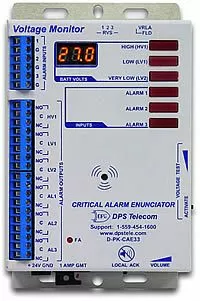Check out our White Paper Series!
A complete library of helpful advice and survival guides for every aspect of system monitoring and control.
1-800-693-0351
Have a specific question? Ask our team of expert engineers and get a specific answer!
Sign up for the next DPS Factory Training!

Whether you're new to our equipment or you've used it for years, DPS factory training is the best way to get more from your monitoring.
Reserve Your Seat Today
At remote sites, nothing is more critical than maintaining a constant power supply to your revenue-generating equipment. When the power goes, everything goes with it, so monitoring your battery plant voltage levels is the most important telemetry job you can do.
The new Critical Alarm Enunciator (CAE) is the right tool for monitoring mission-critical battery levels. The CAE monitors three battery plant voltage threshold alarms and three discrete alarm, provides audiovisual notification to local personnel, and then relays alarms to your NOC via your existing alarm collection equipment.
The CAE provides detailed visibility of battery conditions, by monitoring three distinct. voltage thresholds. The CAE will alert you of high, low, and very low battery levels. You'll know when your battery plant is in trouble, long before it's dead, so you can correct power supply problems before they take down your remote site.
The CAE does more than just monitor voltage thresholds; it also provides a continuously updated reading of live voltage levels through its integrated three-digit voltage display.
The CAE also monitors your whole power supply. It features three discrete alarms, suitable for monitoring circuit breakers, fuses, converters, rectifiers, or inverters. These pass-through alarms give more complete visibility of all aspects of your battery plant. Discrete alarm polarity can be easily reversed using convenient configuration DIP switches.
The CAE's voltage thresholds can be set for different types of battery plant using the configuration DIP switches. You can test the voltage alarms with the CAE's built-in self-test function, which allows you to simulate voltage threshold alarms and confirm the operation of the unit.
As a safety feature, a button must be continuously pressed to use the voltage alarm self-test, so there is no danger of leaving the unit in self-test mode and interfering with alarm reporting.
Local notification of alarms is provided through the front-panel digital voltage display, six alarm notification LEDs and an audible speaker signal. Local visibility is essential for proactive responses to alarm conditions, giving on-site personnel an opportunity to correct alarm conditions without waiting for notification from the NOC.
Even sites that are usually unstaffed can benefit from the CAE's local notification. Visiting technicians can get an immediate at-a-glance view of battery plant status as soon as they enter the remote site. And if an alarm happens while a technician is there, he'll know about it before he leaves, ensuring the problem is fixed fast and eliminating an unnecessary dispatch.
Alarms monitored by the CAE are passed on to your existing alarm collection equipment using standard control relays. You can install local notification at all your remote sites without disrupting your existing monitoring.
The CAE's local alert signal can be silenced by pressing the Local ACK button on the bottom of the unit. The audible alarm will shut off, and the alarm notification will light solid. The alarm LED will remain lit to indicate a standing alarm until the alarm condition is corrected. As a safety feature, pressing the CAE's Local ACK button will not prevent alarms from being relayed to your NOC.
If you have critical battery plants to monitor at your remote sites, the Critical Alarm Enunciator can help. Local and regional visibility, detailed analog voltage monitoring, plus notification of discrete battery plant alarms - the CAE is the right combination of features in a compact, space-saving form.